Making a sourdough starter is easy—all you need is flour and water for our recipe. Don’t worry—our pro tips and troubleshooting topics will help you from start to finish. Follow everything closely, and in days, you will have a fermented, active sourdough starter ready to use!

Already have an active starter? Jump right in and make a loaf of making sourdough bread with starter!
Maybe you’ve heard that making a sourdough starter from scratch is really hard. I used to believe that, too. In fact, when I was first starting out, I got my starter from a friend.
There was a sad ending when the oven was turned on, with a jar of sourdough starter inside. Learn from my mistake! After you make yours, read our article on how to store a sourdough starter so you always have a backup.
Sourdough starter is wild, natural yeast. It’s a simple combination of water and flour that slowly ferments in a warm spot over time.
This living, fermented culture needs nutrients and air to thrive. As a result, you will see bubbly activity occurring daily in your sourdough starter.
Content Covered Here
Ingredient Notes and Substitutions
You only need two ingredients to make a sourdough starter recipe – flour and water! However, the type of flour and water used are important.
Best Flour to Use
- We feed and maintain our starter with unbleached, all-purpose flour. For the best results, start with a fresh bag of high-quality flour like King Arthur and use the same brand and type for the first few weeks.
- If possible, start the starter with rye flour or whole wheat flour for the first day. Rye gives the starter a nutritional boost and makes it more active. If you don’t have it on hand, no worries, unbleached, all-purpose flour will work just fine.
When it comes to most sourdough recipes, use unbleached flour. The bleaching process strips the natural coating of wild yeast on the grain. A sourdough starter thrives on friendly bacteria in the wild yeast.
Using bleached flour won’t ruin your starter, but cause it to become less active over time. If you can’t find unbleached, you can use bread flour instead.
I cannot stress enough the importance of using the same brand of flour for the first few weeks of feedings. The protein percentages can vary from brand to brand, as can the type of wheat used. This can cause a reduction in growth and activity.
Changing brands can cause a decrease in activity. If this happens, it may take a few days of consistent feedings and discards in order to get your starter’s activity level up enough to bake bread.

What about organic flour?
Although some bakers don’t recommend organic flour for feeding newly established sourdough starters, we used organic all-purpose and rye flour in making one of our starters.
Use Filtered water
Water straight from the tap often contains chlorine. If filtered water isn’t an option, let the tap water sit out for 24 hours, so the chlorine can evaporate.
🎯 TFN Pro Tip
If you use organic flour and your starter looks thick and has less bubbly activity, switch to non-organic flour for several feedings.
This sourdough starter recipe makes a 100 hydration-type starter, which means, it has equal amounts of water and flour by weight.
This is where a digital food scale comes in handy. If you use measuring cups, you’ll need twice as much flour as water, since water weighs more than flour.
The Best Environment for Sourdough Starter Fermentation
We’ve already covered the importance of using the right flour and water. The next one is keeping your new starter warm enough to encourage proper fermentation. Keep your sourdough starter in a warm environment as it ferments and grows. It needs a cozy place to ‘snuggle.’ Ideally, it should be in a location that is 75-85°F.
Over the past few years, we have helped troubleshoot many problems with sourdough. The most common issues and questions relate to trying to grow a sourdough starter in too cool an environment.
Storing and feeding sourdough starter in a cooler climate
Cooler indoor temperatures can make it difficult for starters to thrive. We found an inexpensive, handy solution! It’s a low-wattage heating wrap around the storage jar to keep it at the optimal temperature.
🎯 TFN Pro Tip
Pro Tip: I use and recommend this heating wrap to maintain the proper temperature in cooler environments.

Wrap it around the top of the jar, for the ideal amount of indirect warmth.
🎯 TFN Pro Tip
Do not keep your starter in a dark or overly warm place for longer than the first 12 hours. This includes a cabinet, microwave, or an oven with the light turned on. Like living organisms, sourdough starter needs light and air to thrive.
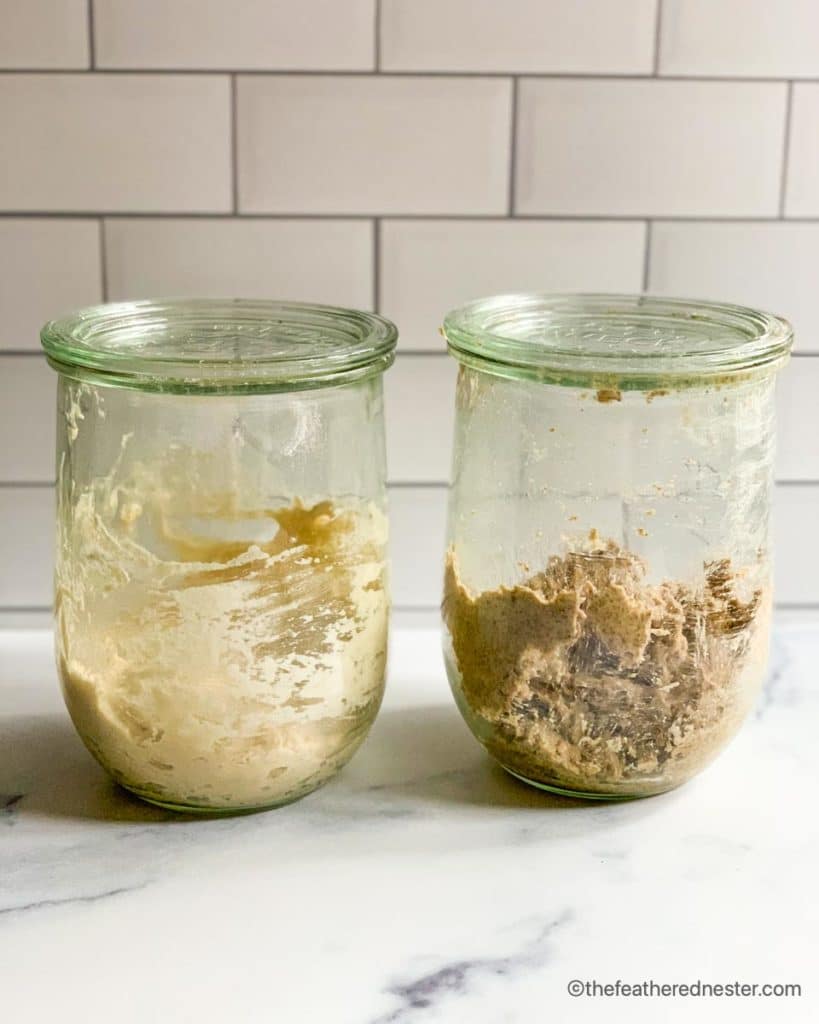
Sourdough Starter Recipe
Day 1
Add the following to a 1-liter glass, ceramic, or stoneware jar or crock:
- 1 cup (120 grams) unbleached, all-purpose flour, rye flour, or whole wheat flour
- 1/2 cup (120 grams) filtered, warm water (85 to 90° F.)
Stir to combine. The mixture will be very thick and pasty. This is normal – do not thin it out! Your sourdough starter needs that flour for fermentation and energy. The mixture thins out 12-24 hours after each feeding.
Day 2
Look for signs of fermentation: tiny bubbles on the bottom of the starter, and pinprick-sized bubbles on top. If you don’t see any signs after 24 hours, ensure your starter is in an area between 75º and 80ºF.

How and When to Feed a Sourdough Starter
Feeding and maintaining your starter is as simple as stirring in more flour and water, and discarding a little bit of the mixture along the way.
What is sourdough discard?
The discard is the portion you remove from a starter during feedings. Throw out the discard for the first 5 days. At this point, it isn’t fully grown and active.
For an established, active sourdough starter, the discard is the portion you will for the recipe you’re making.
Day 3
- Remove 1/4 cup (60 grams) of starter and throw it away.
- Add 1/4 cup (60 grams) of warm, filtered water. Stir to combine, then stir in 1/2 cup (60 grams) of unbleached, all-purpose flour.
🎯 TFN Pro Tip
I recommend adding your water before the flour during feedings.
Watch for signs of activity – larger bubbles and a hungry starter that is thinner than when you mixed it.

Save This Recipe!
Day 4
Your starter might have a strong odor. This is completely normal.
- Remove and discard 1/4 cup (60 grams) of sourdough starter, and stir in 1/4 cup (60 grams) of warm, filtered water.
- Mix in 1/2 cup (60 grams) of unbleached, all-purpose flour.
Day 5
Once again, follow the steps and ingredient amounts from day 4 to feed the sourdough starter. Depending on altitude and temperature, your starter may be active.
If it doubles in size within 4-6 hours of feeding, you can use it if you want to!
We recommend making a low-rise recipe, like old-fashioned sourdough cake or tortillas. Wait until day 7 to make bread.

Feeding an Active Sourdough Starter
By the 6th day, your jar of sourdough starter should be very active and bubbly!
Day 6
- Feed starter normally Once again, remove 1/4 cup (60 grams) of starter. Either discard it, or use it to make a sourdough discard recipe.
- Stir in 1/4 cup (60 grams) of warm, filtered water, then mix in 1/2 cup (60 grams) of unbleached, all-purpose flour.
At this stage of the sourdough starter recipe, you may see the contents double in size 4-6 hours after feeding. After 12 hours, it will have a lot of bubbles and will look very much like a sea sponge.
Day 7
If the contents are doubled in size in 4-6 hours after feeding, you can use it! If not, keep feeding it for a few days, following the same schedule of daily feeding.
It takes a solid, active starter to rise several cups of flour for a loaf of sourdough bread. Consider your first few attempts as a starter or trial loaves. Your starter will become stronger as you feed it over the course of several weeks.

Knowing When Sourdough Starter is Ready to Use
🎯 TFN Pro Tip
Just after feeding a sourdough starter, the contents will be at their lowest point. Use an erasable marker to note the level of the contents, or mark the level with a rubber band around the jar.
Set a timer for 4 hours. How much has your starter risen? Has It doubled? If not, set a timer for 2 more hours. This is the best way to see how much your starter is rising and falling.
Here are some signs that you have an active sourdough starter.
- Your starter is at least 5 days old (for low rise recipes) or 7 days old (for bread).
- Within 4-6 hours of a feeding, your starter consistently doubles in size.
- Your starter looks spongy and full of bubbles all over.
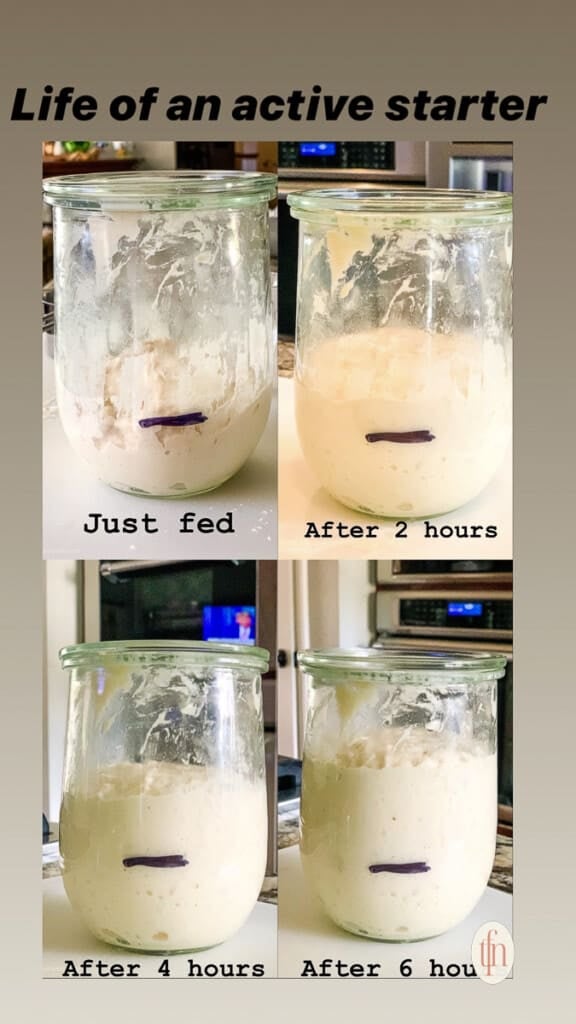
What is the Float Test?
We do not recommend using a “float test” to see if your starter is ready to use. Some perfectly active starters (including the ones we make) never pass this test.
As you can see, though, ours makes amazing sourdough bread.
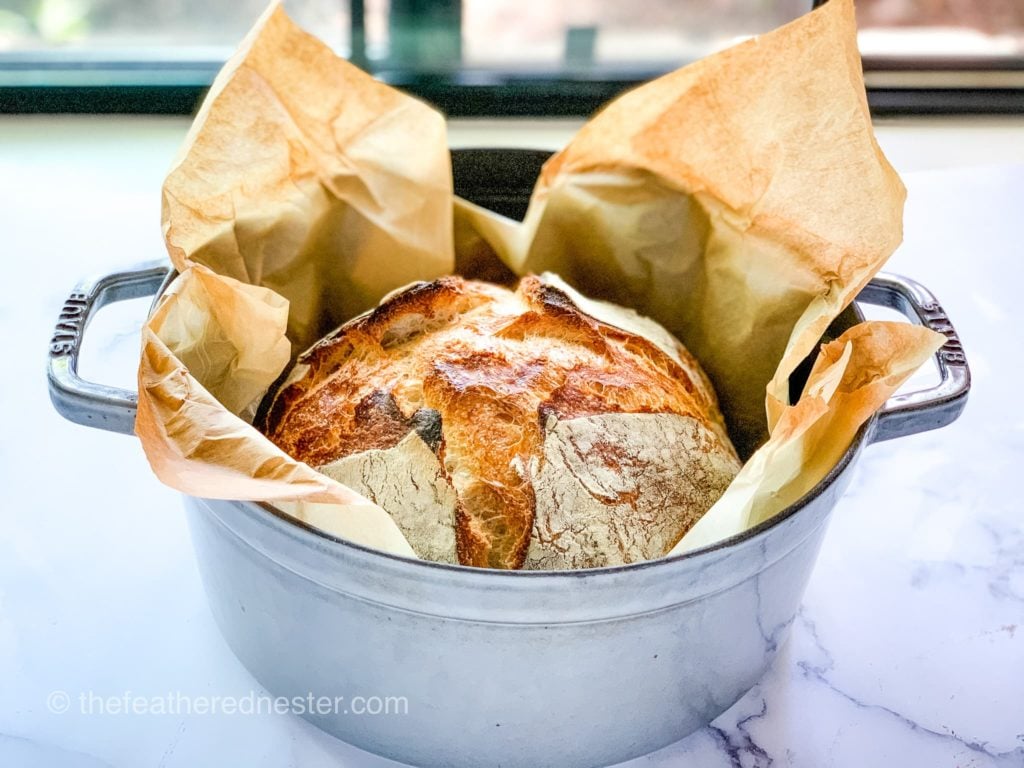
Care and Maintenance
A sourdough starter is a live culture that needs regular feeding to survive.
For weekly (or less frequent) use
Keep the starter in the refrigerator. Take it out 12 hours before you want to use it. Depending on how much starter you need for the recipe, discard (or save for later) half, then feed the remaining starter.
We recommend keeping a discard jar inside of your fridge. perfect for recipes that use a large amount of starter, like sourdough starter cinnamon rolls.
For daily use
If you will be using it every day, keep your sourdough starter on the counter and feed it once daily. 8-12 hours after feeding, it is active and ready to use.
How to bake with your sourdough starter
Feed it as usual 12 hours beforehand by removing 1/4 cup of starter (60 g). Add 1/4 cup of warm, filtered water (60g), then mix in 1/2 cup of unbleached, all-purpose flour (60 g).

How to increase the amount of sourdough starter
There will be times when you need a larger amount of starter for a baking recipe. In that case, you’ll need to know how to increase the sourdough starter. There are two ways to do this:
- Feed your starter without discarding it.
First, measure your starter. For example, if it’s 1 cup of starter, add 1 cup of water and 2 cups of flour. Or, weigh your starter, then add equal amounts of water and flour. - Divide the starter.
If you need a large amount of starter, then split your starter into two containers. Feed both without discarding until you have the amount of starter you need. Save enough to keep your starter, then use the rest for your recipe.
The best container for storing sourdough starter
To keep your starter healthy and active, using a proper container is important. A glass container is ideal. Don’t store your sourdough starter in plastic or metal containers.
After much trial and error over the past several years, we recommend using a Weck 1-liter tulip jar.
If you’re having sourdough starter problems, check our post for easy tips!
Recipe FAQs
Yes and No. We do not recommend making a sourdough starter recipe using bread flour. However, after 7 days, it will be fully active. At that point, you can feed your established sourdough starter with bread flour.
Initially, discarding half of a sourdough starter keeps it a manageable size. Although it may seem difficult or sad to discard half of your starter, it is a necessary step. Do not use the discard for the first 5 days.
Although everyone’s sense of smell is different, as your sourdough starter goes through the stages of fermentation, the smells change.
In the beginning, it may smell fruity or sour. Some people say that they think it smells like sweaty gym socks, and others say it smells yeasty, like beer. All of these aromas are perfectly normal for sourdough starter.
Are you keeping the starter in a warm area, 75 to 85º Fahrenheit? Are you using unbleached all-purpose flour for feedings? And warm, filtered (spring) water for feeding? If so, wait for another day or two – the starter will become active soon!
Consider Making These Easy Sourdough Recipes…
If you tried this sourdough starter recipe or any other recipe on my website, please leave a 🌟 star rating and let me know how it went in the 📝 comments below. Thanks for visiting!
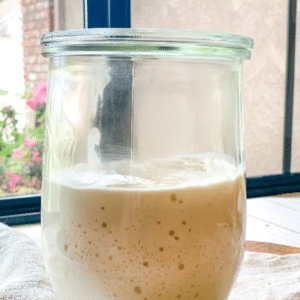
Making and Feeding a Sourdough Starter
Equipment
- glass jar - or ceramic jar, with a tight-fitting lid
Ingredients
Inital starter (day 1)
- 120 grams unbleached all-purpose flour 120 g = 1 cup dry measure. Can substitute with rye flour or whole wheat flour
- 118 grams warm filtered water 118 ml = 1/2 cup liquid measure
Subsequent feedings (day 3 and beyond)
- 59 grams warm filtered water 59 ml = 1/4 cup liquid measure
- 60 grams unbleached all-purpose flour 60 g = 1/2 cup dry measure
Instructions
Creating the starter
- Day 1: In your glass or ceramic container, mix the flour and water. The mixture will be very thick and pasty. Do not thin it out! The starter needs that flour for fermentation and energy.
- Day 2: Look for signs of fermentation: tiny bubbles on the bottom of the starter, pinprick sized bubbles on top. If you don't see any signs after 24 hours, ensure your starter is being in an area that is at least 75º F.
Feeding the starter days 3 and beyond
- Day 3: Remove 1/4 cup of starter (60 g) and discard it. Add 1/4 cup of warm, filtered water (60g) stirring, then mix in 1/2 cup of unbleached, all-purpose flour (60 g). I find it's easier to mix if you add the water first. Watch for signs of activity – larger bubbles and a hungry starter that's thinner in texture.
- Day 4: Your starter might have a strong smell when you open the container to feed it. That's all normal. Remove 1/4 cup of starter (60 g) and discard it. Add 1/4 cup of warm, filtered water (60g) stirring, then mix in 1/2 cup of unbleached, all-purpose flour (60 g).
- Day 5: Remove 1/4 cup of starter (60 g) to discard (see below). Add 1/4 cup of warm, filtered water (60g) stirring, then mix in 1/2 cup of unbleached, all-purpose flour (60 g). Your starter will probably be very active and may be doubling in size within 4-6 hours of a feeding.If your sourdough starter is very active and doubles in size within 6 hours you can use today's discard in a low-rise recipe like or homemade tortillas. Or wait until day 7 and use your starter for baking a loaf of traditional sourdough bread or soft sourdough sandwich bread.
- Day 6: By now, your starter should resemble a sponge 12 hours after feeding. It should be doubling in size 4-6 hours after feeding. If not, see my troubleshooting tips. Feed starter normally: remove 1/4 cup of starter (60 g) as the discard (use or toss), and add 1/4 cup of warm, filtered water (60g) stirring, then mix in 1/2 cup of unbleached, all-purpose flour (60 g).
- Day 7 and beyond: If your starter is fully active, has been doubling in size within 4-6 hours after feeding, it's ready! If not, keep feeding it for a few more days, following the same schedule.To use it for baking, feed it as usual 12 hours beforehand: remove 1/4 cup of starter (60 g) and set aside for baking, and add 1/4 cup of warm, filtered water (60g) stirring, then mix in 1/2 cup of unbleached, all-purpose flour (60 g).
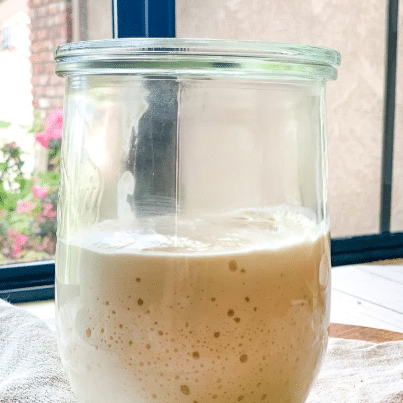


Ellen says
Hi there! So excited to make my 1st starter! Started yesterday, removed and added today and within an hour it doubled again and is still growing 😳should I tap it down, or stir it?
Renae says
Hi Ellen, yay on starting your sourdough journey! I leave my starter alone until the next feeding. When I started the new one for that blog post, I noticed that the first few days it was very bubbly – but then that tapered off. So don’t be alarmed if that happens. By day 5-6 it will double in size again within the first several hours.
Kelly says
I’ve been doing to discard and feedings daily but my starter is thin. Am I supposed to be keeping the tulip lid on it or something more breathable?
Renae says
Double-check your ratios or starter to flour and water – if you are using cup measurements then it’s twice as much flour as starter or water. If you are weighing your measurements, then it’s equal weights of each. The starter mixture should be thick and pasty when you feed the starter, then it will become thinner between feedings. Use the glass lid on top of your jar – without the gasket or clamps. The starter will get plenty of air with just the glass lid on.
Jan Hardenbrook says
I am on day 6 and am seeing bubbles but it has not doubled in size in the jar. On day 3 I was so excited because I did see doubling but since it has completely stopped. I am hopeful because it does look spongy and there are visible bubbles. I have kept at 75 to 85 degrees at all times and have been very precise with weighing flour and using the filtered warm water. Tomorrow will be day 7. What happens if it does not double today???
Jan
Renae says
Hi Jan, your starter sounds a little sluggish. A couple of things come to mind to help kick the activity up. Are you able to observe the starter for the first 12 hours after feeding? If we are feeding it at night we miss seeing the peak activity of the starter. If so, you might see that the sides of the jar have residue leftover from when the starter peaked overnight. If it’s during the daytime and you are able to observe its activity then we’ll move on to the flour. Are you are using unbleached, all-purpose flour (not organic)? If so, and you have access to whole wheat flour or rye flour, I’d swap 1/2 of your app purpose flour for that on your next feeding. Are you keeping it in a covered jar? If it’s the Weck jar, you’d use the glass lid without the rubber gasket and clamps. If it’s a canning jar, don’t use the sealing lids – use plastic wrap with a rubber band. If you’re still having issues, send me some photos to my email at renae@thefeatherednester.com so I can see what your starter looks like.
Karen says
I’ve been doing this wrong all along. Lol. For some reason, although I read it a hundred times I was discarding the half cup I remove. I’m like “this is working but it’s a little weak”. Starting today I will do the 1:1:1. Indont know why I didn’t get that until I read some other stuff that used 1:1:1. You might just make that a little clearer for idiots like me. But I do think it’s coming along.
Renae says
So glad to hear your starter is coming along. I use a weighted 1:1:1 formula for this starter, not measured 1:1:1 (though some people do). The starter mixture should be thick, like my photos show. Thanks for the suggestion, I’ll take a look and see how I can make it clearer in my instructions.
Jessica says
Just getting into sourdough baking. Can you explain how is this a 1:1:1 formula?
The first feeding would be 60g starter + 60g water + 60g flour (which is a 1:1:1)
Second feeding, removing 60g starter would leave you with 120g starter + 60g water + 60g flour (isn’t this 1:.5:.5?)
Third feeding, removing 60g would leave you with 180g starter + 60g water + 60g flour (isn’t this 1:.33:.33?)
If it’s a 1:1:1, shouldn’t the second feeding be 120g water + 120g flour? And third should be 180g water + 180g flour?
Renae says
1:1:1 refers to the ratio of the feeding and hydration level. As the starter discard is thrown out at each feeding in the beginning, we want to use smaller feeds initially. Since you’re always using equal measurements of flour and water, the size of your starter you keep is immaterial since it is also equal measurements of flour and water. Follow my directions and you’ll be rewarded with an amazing starter in 5-7 days.
Robin says
I made the same mistake🤦🏻♀️Took me three weeks to realize what was going wrong! Finally made my first beautiful artisan loaf yesterday. Tomorrow I will try the sandwich loaf!
Karen Chuplis says
Most starter recipes say to feed twice a day. These are just once a day right?
Renae says
Yes, I only fed this starter once a day.